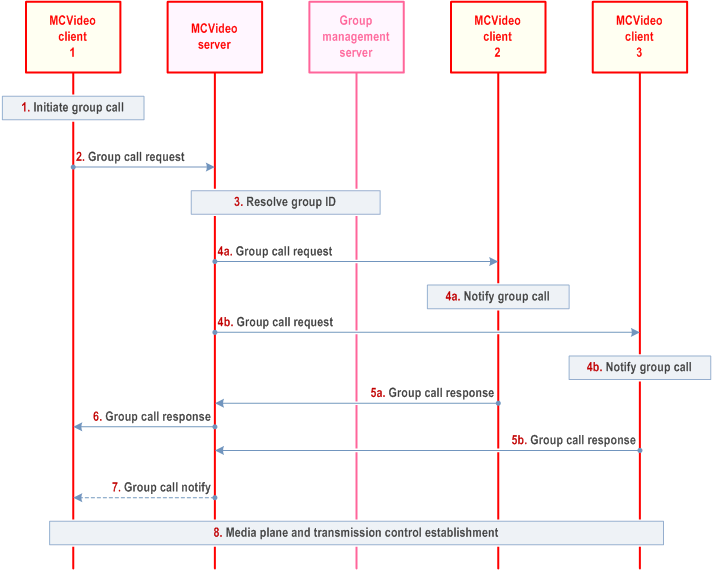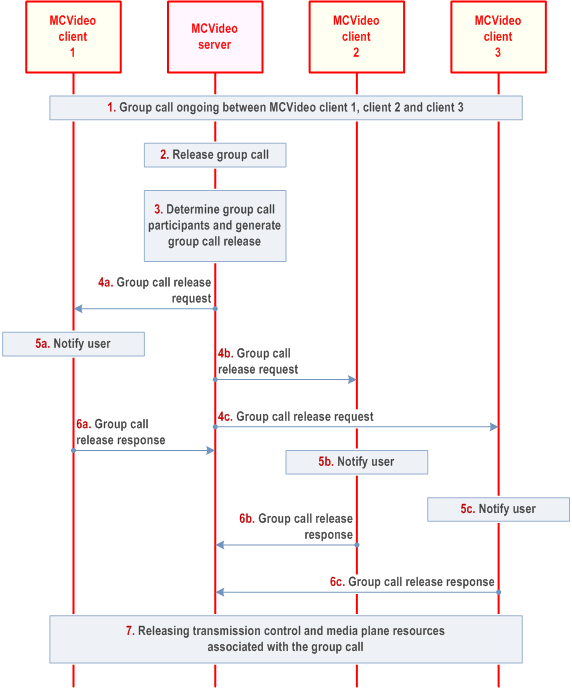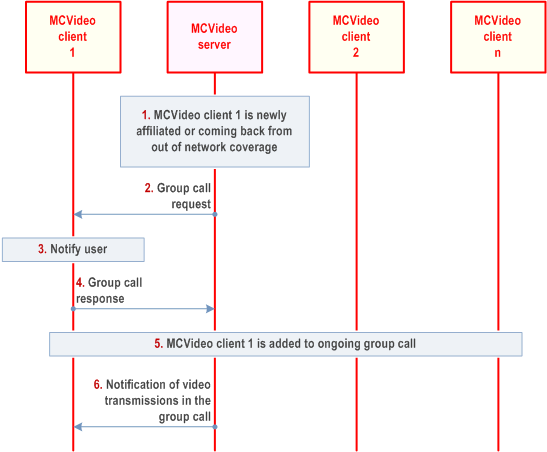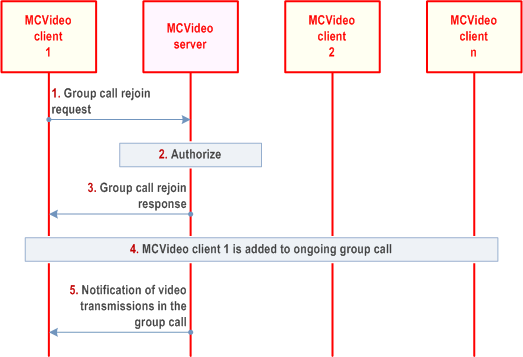Content for TS 23.281 Word version: 19.2.0
1…
5…
6…
7…
7.1.2.3…
7.1.2.3.1.2…
7.1.2.3.2…
7.1.2.4…
7.1.2.5.2…
7.1.3…
7.2…
7.2.2.3…
7.2.2.4…
7.2.3…
7.3…
7.4…
7.4.3…
7.5…
7.5.2.3…
7.6…
7.7…
7.7.1.3…
7.7.1.3.2A…
7.7.1.3.4…
7.7.1.3.6…
7.7.2…
7.7.2.7…
7.7.2.9…
7.8…
7.11…
7.17…
7.19…
7.19.2.8…
7.19.3…
7.19.3.1.4…
7.19.3.2…
7.19.3.2.3…
7.19.3.2.6…
A…
7.1.2.3 Group call within one MC system
7.1.2.3.1 Group call models
7.1.2.3.1.1 Pre-arranged group call
7.1.2.3.1.1.1 General
7.1.2.3.1.1.2 Pre-arranged group call setup
7.1.2.3.1.1.3 Release pre-arranged group call
7.1.2.3.1.1.4 Late entry pre-arranged group call
7.1.2.3.1.1.5 Rejoining call
...
...
7.1.2.3 Group call within one MC system p. 29
7.1.2.3.1 Group call models p. 29
7.1.2.3.1.1 Pre-arranged group call p. 29
A pre-arranged group call is initiated by one of the affiliated group members. The initiation of a pre-arranged group call results in all other affiliated group members being invited. Media plane resources are reserved (on-demand) or a pre-established session is associated during the group call setup procedure and released (if on-demand session) or de-associated (if pre-established session) when the call is released. SIP signalling is used to setup and release pre-arranged group calls.
The procedure enables the scenario where an MCVideo client is initiating an MCVideo group call with unicast signalling for communicating with the affiliated members of that group.
Procedures in Figure 7.1.2.3.1.1.2-1 are the signalling control plane procedures for the MCVideo client initiating establishment of an MCVideo group call with a pre-arranged group i.e., MCVideo users on client 1, client 2 and client 3 belong to the same group which is defined in the group management server.
Pre-conditions:
- A pre-arranged group is an MCVideo group that is pre-defined with MCVideo group ID and member list in the group management server. All members of the group belong to the same MC system.
- It is assumed that MCVideo users on MCVideo client 1, MCVideo client 2 and MCVideo client 3 are already registered for receiving MCVideo service and affiliated.
- The MCVideo client 1 may have an activated functional alias to be used.
- The MCVideo server may have subscribed to the MCVideo functional alias controlling server within the MC system for functional alias activation/de-activation updates.
- The MCVideo user on MCVideo client 1 may have bound a functional alias to the MCVideo group ID (TS 23.280).

Step 1.
User at MCVideo client 1 would like to initiate an MCVideo group call with a selected group (identified by MCVideo group ID). The MCVideo user at MCVideo client 1 may include a functional alias used within the MCVideo group call.
Step 2.
MCVideo client 1 sends a group call request towards the MCVideo server via the SIP core, which hosts the group selected by the user and identified by MCVideo group ID. The group call request also contains the MCVideo group ID and an SDP offer containing the MCVideo client media parameters. If the MC service user of MCVideo client 1 has selected a functional alias, then the group call request contains that functional alias. If there is a transmit media request, then the group call request contains an indication for the implicit transmit media request. If the group call request contains an implicit transmit media request it may also include location information.
Step 3.
MCVideo server checks whether the user of MCVideo client 1 is authorized to initiate a group call for the selected group. If a functional alias is present, the MCVideo server checks whether it is allowed to be used and if it has been activated for the user. If authorized and the group call is ongoing for that MCVideo group ID, the MCVideo server adds the requesting MCVideo client 1 to the existing MCVideo group call and notifies the MCVideo client 1 that the MCVideo group call is already in progress. Otherwise, MCVideo server resolves the MCVideo group ID to determine the members of that group and their affiliation status, based on the information from the group management server.
If the functional alias is provided only in the group call request, or via binding, the MCVideo server proceeds with the value that is provided. If the functional alias is provided in both the group call request and via binding, it is up to the MCVideo server implementation to determine a value for the functional alias to be used.
Step 4.
MCVideo server includes information that it communicates using MCVideo service, offers the same media parameters or a subset of the media parameters contained in the initial received request and sends the corresponding group call request via the SIP core towards the MCVideo clients of each of those affiliated group members. MCVideo users are notified about the incoming group call and, if present, the functional alias of the initiating MC service user is displayed. The MCVideo server indicates whether acknowledgement is required for the call.
Step 5.
The receiving MCVideo clients accept the group call request, and a group call response is sent to the group host MCVideo server. This response may contain an acknowledgement. The conditions for sending acknowledgement may be based on configuration.
Step 6.
MCVideo server sends the group call response including the selected media parameters to the MCVideo client 1 through the signalling path to inform about successful call establishment.
Step 7.
If the initiating MCVideo user requires the acknowledgement from affiliated MCVideo group members, and the required MCVideo group members do not acknowledge the call setup within a configured time (the "acknowledged call setup timeout"), then the MCVideo server may proceed with or abandon the call and then notify the initiating MCVideo user that the acknowledgements did not include all required members according to group policy. This notification may be sent to the initiating MCVideo user by the MCVideo server more than once during the call when MCVideo users join or leave the MCVideo group call.
Step 8.
MCVideo client 1, client 2 and client 3 have successfully established media plane and transmission control for communication.
The procedure enables the scenario where an MCVideo server initiates the termination of an ongoing MCVideo group call for all the participants of that group call, since at least one of the termination conditions are met e.g., last participant leaving, second last participant leaving, initiator leaving, or minimum number of affiliated MCVideo group members are not present.
Procedures in Figure 7.1.2.3.1.1.3-1 are the signalling control plane procedures for the MCVideo server initiating termination of an ongoing MCVideo group call.

Step 1.
It is assumed that MCVideo users on MCVideo client 1, client 2 and client 3 are already part of the ongoing group call (e.g., as a result of pre-arranged group call setup).
Step 2.
MCVideo server would like to release the MCVideo group call which is ongoing e.g., last participant leaving, initiator leaving, or minimum number of affiliated group members are not present.
Step 3.
MCVideo server identifies the participants of the ongoing group call and generates group call release request to release ongoing session.
Step 4.
MCVideo server sends a group call release request via SIP core towards each participant of the ongoing group call.
Step 5.
MCVideo users are notified about the release of the group call.
Step 6.
MCVideo client(s) receiving group call release request, acknowledge towards the MCVideo server by sending a group call release response.
Step 7.
MCVideo client 1, client 2 and client 3 have successfully released the media transmission control and media plane resources associated with the group call that is terminated.
Procedures in Figure 7.1.2.3.1.1.4-1 are the signalling control plane procedures for the MCVideo server requesting a newly affiliated member or a member coming back from out of coverage to join an ongoing MCVideo group call.
Pre-conditions:
- MCVideo group is previously defined on the group management server with MCVideo users affiliated to that group. All members of the group belong to the same MC system.
- It is assumed that MCVideo users on MCVideo client 2 to MCVideo client n are on an ongoing call.
- Optionally, the MCVideo client 1 may have activated functional alias to be used.
- The MCVideo server may have subscribed to the MCVideo functional alias controlling server within the MC system for functional alias activation/de-activation updates.

Step 1.
MCVideo server determines that MCVideo client 1 which is newly affiliated or coming back from out of coverage has to be invited to join an ongoing group call (late entry).
Step 2.
MCVideo server generates group call request including the information such as MCVideo service identifier (possible for the SIP core to route the request to the MCVideo server), MC service group ID of the group invited to join, offer one or more media types and sends towards the MCVideo client 1 via SIP core.
Step 3.
MCVideo user at MCVideo client 1 is notified about the incoming group call.
Step 4.
Upon MCVideo user at MCVideo client 1 accepting the incoming group call request, MCVideo client 1 sends the group call response including the selected media types to the MCVideo server through the signalling path. If the incoming group call request is rejected by the MCVideo client 1, the MCVideo server should not resend the group call request
Step 5.
MCVideo client 1 is successfully added to the ongoing group call and MCVideo users at MCVideo client 1 to MCVideo client n may be notified about the MCVIDEO client 1 joining the group call.
Step 6.
A notification with the information of media transmissions in the group call is sent to MCVideo client1.
Procedures in Figure 7.1.2.3.1.1.5-1 are the signalling control plane procedures for the MCVideo client to rejoin an ongoing MCVideo group call (e.g. coming back from out of coverage).
Pre-condition:
- It is assumed that MCVideo users on MCVideo client 2 to MCVideo client n are on an ongoing call.
- Optionally, the MCVideo client 1 may have activated functional alias to be used.
- The MCVideo server may have subscribed to the MCVideo functional alias controlling server within the MC system for functional alias activation/de-activation updates.

Step 1.
MCVideo client 1 has necessary information for rejoining an ongoing group call, then the MCVideo client 1 initiates group call rejoin request including the ongoing group call information. The MCVideo user at MCVideo client 1 may include a functional alias used within the MCVideo rejoin request.
Step 2.
MCVideo server checks whether the MCVideo client 1 can rejoin the ongoing call (e.g. based upon affiliation status) and checks the functional alias, if present.
Step 3.
MCVideo client 1 is informed that the group call rejoin is successful by sending a group call rejoin response.
Step 4.
MCVideo client 1 is successfully added to the ongoing group call and MCVideo users at MCVideo client 1 to MCVideo client n may be notified about the MCVideo client 1 joining the group call and the functional alias of MCVideo client 1 may be displayed.
Step 5.
A notification with the information of media transmissions in the group call is sent to MCVideo client 1.